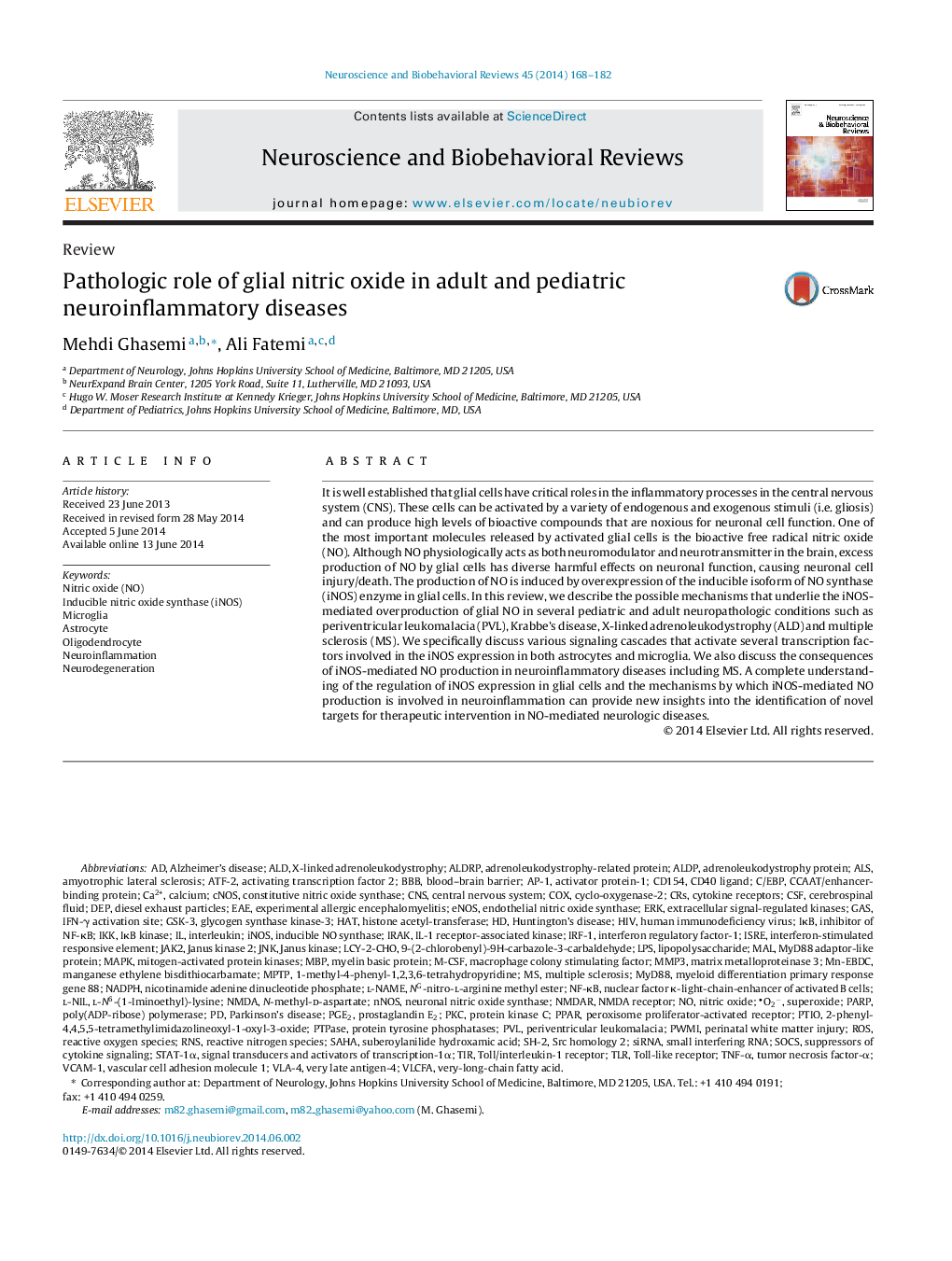| Article ID | Journal | Published Year | Pages | File Type |
|---|---|---|---|---|
| 7303970 | Neuroscience & Biobehavioral Reviews | 2014 | 15 Pages |
Abstract
It is well established that glial cells have critical roles in the inflammatory processes in the central nervous system (CNS). These cells can be activated by a variety of endogenous and exogenous stimuli (i.e. gliosis) and can produce high levels of bioactive compounds that are noxious for neuronal cell function. One of the most important molecules released by activated glial cells is the bioactive free radical nitric oxide (NO). Although NO physiologically acts as both neuromodulator and neurotransmitter in the brain, excess production of NO by glial cells has diverse harmful effects on neuronal function, causing neuronal cell injury/death. The production of NO is induced by overexpression of the inducible isoform of NO synthase (iNOS) enzyme in glial cells. In this review, we describe the possible mechanisms that underlie the iNOS-mediated overproduction of glial NO in several pediatric and adult neuropathologic conditions such as periventricular leukomalacia (PVL), Krabbe's disease, X-linked adrenoleukodystrophy (ALD) and multiple sclerosis (MS). We specifically discuss various signaling cascades that activate several transcription factors involved in the iNOS expression in both astrocytes and microglia. We also discuss the consequences of iNOS-mediated NO production in neuroinflammatory diseases including MS. A complete understanding of the regulation of iNOS expression in glial cells and the mechanisms by which iNOS-mediated NO production is involved in neuroinflammation can provide new insights into the identification of novel targets for therapeutic intervention in NO-mediated neurologic diseases.
Keywords
NF-κBLPSCOXJnkMYD88MBPVLCFANADPHMALERKCRSDEPiNOSPGE2RNSPPAReNOSIκBEAEMPTPJAK2NMDAN-methyl-d-aspartatenNOSAP-1TLRPKCNMDARIKKcyclo-oxygenase-2PARPGSK-3SAHASOCSVCAM-1VLA-4M-CSFCD154ISREJanus Kinase 2cNOSNG-nitro-l-arginine methyl esterMMP3IRF-1nuclear factor κ-light-chain-enhancer of activated B cellsX-linked adrenoleukodystrophyATF-2ALDPAdrenoleukodystrophy proteinL-N6-(1-iminoethyl)-lysineJanus kinase1-methyl-4-phenyl-1,2,3,6-tetrahydropyridineC/EBPCa2+IκB kinasel-NAMEl-NILMAPKNMDA receptorinducible NO synthaseO2−PTpasePTIOSmall interfering RNAROSsiRNAALDAstrocyteexperimental allergic encephalomyelitisamyotrophic lateral sclerosisSuberoylanilide hydroxamic acidVery-long-chain fatty acidNeuroinflammationOligodendrocyteinterleukinAlzheimer's diseaseALSHuntington's diseaseParkinson's diseaseNeurodegenerationtumor necrosis factor-αTIRToll-like receptorvery late antigen-4CNSDiesel exhaust particlesBBBBlood–brain barriersuppressors of cytokine signalingendothelial nitric oxide synthaseneuronal nitric oxide synthaseInducible nitric oxide synthase (iNOS)constitutive nitric oxide synthaseSuperoxidecentral nervous systemIRAKmacrophage colony stimulating factorinterferon regulatory factor-1TNF-αactivating transcription factor 2Periventricular leukomalacialipopolysaccharideCD40 ligandMatrix metalloproteinase 3Cerebrospinal fluidCSFPVLinhibitor of NF-κBMultiple sclerosisVascular cell adhesion molecule 1MicrogliaNitric oxideNitric oxide (NO)nicotinamide adenine dinucleotide phosphateSrc Homology 2histone acetyl-transferaseHIVhuman immunodeficiency virusmyeloid differentiation primary response gene 88CCAAT/enhancer-binding proteinprotein tyrosine phosphatasesactivator protein-1Myelin basic proteinProtein kinase CProstaglandin E2Poly(ADP-ribose) polymeraseHATCalciumIL-1 receptor-associated kinaseextracellular signal-regulated kinasesmitogen-activated protein kinasesGasglycogen synthase kinase-3reactive nitrogen speciesReactive oxygen speciesToll/interleukin-1 receptorperoxisome proliferator-activated receptorCytokine receptors
Related Topics
Life Sciences
Neuroscience
Behavioral Neuroscience
Authors
Mehdi Ghasemi, Ali Fatemi,
